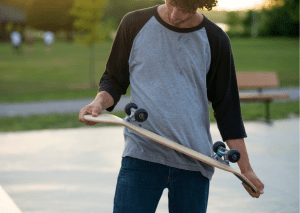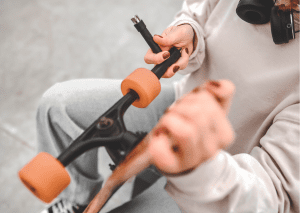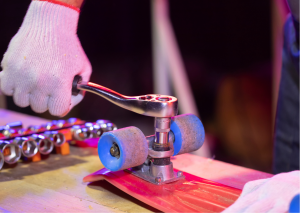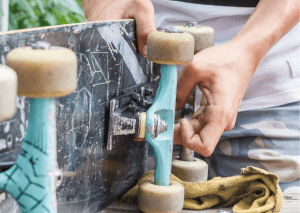We’ve all been eager to hit the pavement with our skateboards, feeling the wind rush by. But ensure skateboarding safety first! Ensure all measures are taken for optimal skating conditions. Take a seat, and read through our safety guide blog here in FamilyHype for free.

Everyone knows that caution should always come first, especially when it comes to skateboarding. This article is here to share some important and secure inspection ideas you can take before each ride. By inspecting your board’s deck, trucks, wheels, bearings, and grip tape, you can follow essential safety electric skateboard guidelines and safety rules.
Not only will these inspections help prevent potential skateboarding injuries, but they could also extend the life of your board. You can get to know these pre ride ideas for electric skateboards – because a safe riding experience matters just as much as the fun does!
By performing these secure inspections and following a thorough pre ride checklist and after ride checklist, you can ensure your boards are in optimal condition for a stay safe and enjoyable ride. Always remember to hone your riding skills and avoid sudden movements that might lead to accidents. Embrace these electric skateboard safety measures for a seamless and secure ride.
Skateboard Safety Check
Key Takeaways
- Everyone knows the importance of a quick inspection. This article covered the basics of skateboard protection checks.
From inspecting the skateboard’s deck, checking the trucks and wheels, testing the bearings, evaluating the grip tape, and assessing the board’s protective gear like helmets and pads, we are confident you are now better equipped to make sure your ride is safe.
Remember, skateboarding is a sport where safety is of the utmost importance, so we can’t stress enough how essential it is for you to inspect your skateboard before riding.
- Hope this guide gives you the knowledge and tools to keep your skateboard in top riding condition.
Pre-Ride Skateboard Safety Check
Skateboard Safety Check
Perform Deck Checks
- Before hitting the street, inspect your deck for cracks, wear, or tear. Replace it immediately if needed. Check the trucks, bushings, kingpins, and axles as well. Safety first!
- The deck includes grip tape for traction and is typically made of maple wood, plastic, or carbon fiber. Regularly inspect your deck and trucks, and consider replacing parts like the helmet for safe sports activities.
Inspect The Trucks
It is important to prioritize the security of users and their families. That’s why for our first skateboarding safety tip, it’s important to inspect the trucks on your skateboard – they’re essential for a smooth and safe ride. It is vital to prioritize electric skateboard safety to ensure no accident might happen.
Make sure to inspect truck tightness, as a loose truck could cause instability and an overly tight truck will hamper maneuverability. Additionally, consider replacing worn-out trucks to ensure optimum performance and security. Following electric skateboard guidelines is part of the pre ride checklist that ensures essential safety for every rider.
Skateboarding is a great way to have fun and enjoy the outdoors, but only if we prioritize well-being. To make sure you’re getting the most out of your skateboarding experience, don’t forget to check the trucks and wheels of your board as part of your pre ride ideas for electric skateboards.
Once you’ve given them an inspection, you’ll be ready to hit the streets, ensuring safe riding and adhering to safety rules. By doing so, you can avoid sudden mishaps and reduce the risk of skateboarding injuries. Always remember, an after ride checklist can also help you stay safe by identifying any issues that need attention before your next ride.
Look At The Wheels
Shifting your gaze to the wheels, you should check for any noticeable cracks or wear that could make your skateboarding experience less than optimal.

The wheel type is essential and should suit your skating style and terrain. Wheels are typically constructed using urethane, polyurethane, or plastic, and can be either hard, soft, or a combination of the two. Harder wheels are great for street skating, while softer wheels are best for cruising.
Making sure those bearings are in top-notch condition is also important for an enjoyable ride.
Test The Bearings
When it comes to skateboards, it’s important to pay attention to the details. It is recommended to know about the spinning of those bearings, listen for any grinding noise, or feel for any roughness that might signal they’re due for a replacement.
Keeping bearings clean and lubricated is essential for security and smooth ride, so make sure to familiarize yourself with cleaning methods to remove dirt and grime and explore lubrication options to extend their life span.

From grip tape to wheels, trucks, and bearings, it’s important to regularly inspect your skateboard to ensure everyone’s security. Evaluating the grip tape’s condition is an important part of this process, especially as part of your pre ride checklist and pre ride ideas for electric skateboards. Following electric skateboard guidelines and ensuring electric skateboard safety are crucial steps in this inspection.
Regularly checking these components is essential safety for every rider. Make sure to avoid sudden wear and tear by maintaining your skateboard diligently. Adhering to safety rules can significantly reduce the risk of skateboarding injuries. Additionally, an after ride checklist helps ensure safe riding by identifying any issues that need attention before your next ride.
Evaluate The Grip Tape
It’s crucial to assess the condition of your grip tape regularly, as it plays a key role in maintaining control and stability while you’re riding. This is one of the pre ride ideas for electric skateboards that ensures essential safety for every rider.
Inspect grip strength, tape durability, dirt accumulation, and smoothness. These aspects are essential, so make sure to examine them regularly. Following electric skateboard guidelines will help you maintain these components effectively.
Grip strength is a primary attribute to assess – ensure it’s not wearing thin. It’s also important to scrutinize tape durability for peeling or tearing. Maintaining electric skateboard safety involves regular checks to avoid sudden issues that could compromise your ride.
Dirt accumulation is also a key factor – a clean surface will provide better traction. You should also evaluate smoothness, as bumps can affect balance. Regular inspections contribute to safe riding.
Maintaining these aspects will greatly enhance your well-being. Make sure to remember all of these safety tips that we just mentioned. These safety tips serve as a guideline on what you should look out for, ensuring a safe and enjoyable riding experience.
Skateboard Safety Check
Final Inspections
Wrapping up our grip tape evaluation, we’re now at the final pre ride checks of our safety tips guide. Your helmet is your number one defense in case of a tumble, and don’t forget to wear protective gear either: knee pads, elbow pads, and wrist guards.
This gear is essential to shield you from scrapes and fractures while riding your skateboard. So let’s make sure we’re completely covered before hitting the pavement for that thrilling ride!
Skateboarding is a thrilling sport, but protection should always be a top priority. Follow tips for staying protected, and be aware of security laws and policy when riding a skateboard. It’s crucial to prepare for preventable injuries, and consulting safety professionals can help you enjoy this exhilarating sport responsibly, whether you’re at the skate park or learning how to ride a skateboard. When it comes to safety, there are things to consider: a close and secure helmet (protection, style, fitment), protective gear (knee pads, elbow pads, wrist guards), and skateboard (deck, trucks, wheels).

As you can see, having the right protection gear is essential for a safe and enjoyable ride.
Remember, security should always come first when it comes to skateboarding. Make sure to equip yourself with the right protective gear before hitting the pavement, be wary of all the safety tips that are mentioned.
Conclusion
Safe Skateboarding: Skate Check
We’ve covered the basics of pre ride ideas for electric skateboards and safety tips, including inspecting the deck, inspecting trucks and wheels, testing bearings, evaluating grip tape, and assessing the board’s protective gear like helmets and pads. With these electric skateboard guidelines, we’re certain you’re better equipped to ensure your ride’s safe. Remember, it’s always worth taking these few extra minutes for a thorough assessment, as safe riding is crucial in a sport where protection is of the utmost importance. Staying safe is important at all times.
Skateboard Safety Check
Frequently Asked Questions (FAQs):
How Can You Ensure Your Safety While Cruising On A Skateboard?
To be safe while riding a skateboard, always wear appropriate protective gear, including a helmet to protect your head, knee pads, and elbow pads. Moreover, practice your balance and learn the basic skills before attempting complex tricks to avoid a serious injury. Be aware of other riders as well, as collisions can happen. Keep in mind of the safety tips that are mentioned above, whether you’re riding at home or at an open area.
How To Prepare For Skateboard Riding With Proper Safety Gear in Mind?
To ensure a safe and enjoyable experience when preparing for skateboard riding, it is essential for beginners to invest in a quality skateboard and proper protection gear. Before venturing onto the pavement or navigating traffic, it is crucial to become familiar with the skateboard, practicing basic maneuvers such as braking. Additionally, it is advisable to study and understand the rules of the road, similar to how one would for cycling. This comprehensive approach, encompassing both equipment and knowledge, sets a high foundation for a safer and more confident skateboarding experience.
How Do You Prevent Injuries In Skateboarding?
To prevent injuries in skateboarding, always wear your safety gear and make sure it’s properly fitted. Make sure to always find yourself protected when cruising because it’s not good to rely at brakes all the time, much more if you’re still a beginner. Excuses won’t save you from injury. Moreover, learning proper techniques, including how to fall correctly, can reduce the risk of severe injuries. For example, skaters learn to fall in a way to distribute the impact over a larger body area, minimizing the risk. But as we all know, injuries are normal no matter how hard we try on staying safe, it’s up to you to minimize the damages.
Do I Need A Ride Skateboard Safety Check?
Yes, you should regularly inspect your skateboard for any damage. Inspecting the deck, wheels, and brakes for cracks, wear, and tear can help ensure safe rides. This is not a minimum precaution, but a fine point that might support your protection. Just like with any sports, a quick safety check is a must in the menu.
What Safety Gear Is Essential To Mitigate The Risks Of Skateboarding And Prevent Aerious Injury?
The risks of skateboarding include the potential for serious injury, making it crucial to prioritize protection by using appropriate gear such as helmets, knee pads, elbow pads, and other protective equipment. Wearing proper gear can significantly reduce the likelihood of serious injuries while engaging in skateboarding activities. Be mindful of practicing each skateboarding safety tip that we mentioned here.
How Can You Stay Secure On A Longboard, Especially When Considering The Use Of Wrist Guards?
- To ensure safety while skateboarding, prioritize the right gear like wrist guards and a helmet to minimize head injury risk. Be cautious on wet surfaces to avoid accidents. Follow regulations in public spaces and exercise caution. Adult supervision is advisable for younger riders. Regular maintenance of your skateboard ensures proper functioning and reduces accident risks. Be mindful of obstacles and terrain conditions. Wear protective gear, especially for wrists. When sharing spaces with cyclists or pedestrians, be courteous and share responsibly.
How Do You Wear Skateboard Safety Gear?
Secure gear typically includes a helmet, knee pads, elbow pads, and wrist guards. Each item should fit snugly but comfortably, with helmets secured by a strap under the chin—make sure to buckle it—and pads strapped securely around the appropriate joints. By wearing safety gear, you can feel protected and good as you cruise the road.
How Do Skaters Wear?
Skaters typically wear loose, comfortable clothing that allows for a wide range of motion. Protective gear is also a common part of a skater’s outfit, including helmets and pads. No matter the range of movements you intend to skate, don’t lose sight of safety, especially for rider kids. Whether you’re skating on a traditional skateboard or an electric board, it’s crucial to ensure that all riders are fully protected.
Considering the weather conditions and choosing the appropriate gear is essential. Additionally, remember that just like cyclists need to follow bike safety rules, skateboarders have similar rights and responsibilities to ensure safe riding. Always keep an eye on your speed and never skip wearing your protective gear. Taking the time to prepare and staying informed on safety topics can make a significant difference in preventing accidents and injuries.
How Do Skaters Fall And Not Get Hurt?
Just like other kinds of vehicle such as electric bike and a scooter, skateboard riders are also prone to falling. Skaters, when preparing for their rides, should prioritize a secure inspection, ensuring their equipment is in optimal condition. Essential protective equipment, including helmets, plays a crucial role in mitigating the risk of head injuries. Additionally, wearing other gear is imperative for overall protection. Skaters should also be cautious about venturing into areas with motor vehicles and avoid riding with more than one person for security reasons. Be cautious on crowded areas where skateboarding seem to be impossible. Learning how to fall correctly is a fundamental skill, emphasizing the importance of rolling to distribute the impact over a larger area and avoiding vulnerable areas like wrists.
What To Do When You First Get A Skateboard?
When you first get a skateboard, an electric bike, or a scooter, the first thing you should to is to familiarize yourself with its components and how it feels under your feet. Start with basic balance exercises before gradually progressing to movement and simple tricks. Remember, beginners can also enjoy the sport without risking unnecessary injury. If you’re unsure about balancing exercise, you may refer online through skateboarding guides by messaging through their blog contact. Aside from the blog contact, you can utilize the comment section and ask for insights from other skaters.
DISCLAIMER (IMPORTANT): This information (including all text, images, audio, or other formats on FamilyHype.com) is not intended to be a substitute for informed professional advice, diagnosis, endorsement or treatment. You should not take any action or avoid taking action without consulting a qualified professional. Always seek the advice of your physician or other qualified health provider with any questions about medical conditions. Do not disregard professional medical advice or delay seeking advice or treatment because of something you have read here a FamilyHype.com.